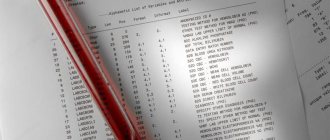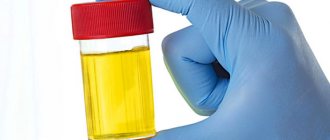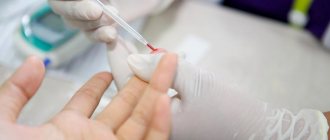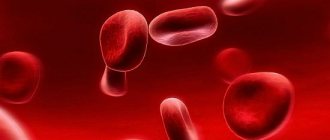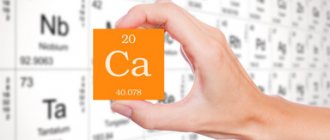You are here: Blood test -
Blood chemistry -
Biochemical blood test in children
- Indications for the study
- Indicators and norm
- Deviation from the norm
- Preparing for the test
A biochemical blood test in children acts as the most informative test, which allows not only to assess the general health of the body in infants or older children, but also to identify even the most dangerous diseases at the very early stages of development, long before the appearance of characteristic clinical signs.
When interpreting the results, the hematologist uses a generally accepted form, which contains absolutely all the values of the biochemical study of the main biological fluid of a person.
Not in all cases the permissible values coincide with the blood parameters of a particular child. The norms for each substance can fluctuate both up and down. This is often influenced by factors that have a pathological basis, but the following may also be the causes:
- inappropriate use of medications;
- malnutrition of the child;
- excessive physical fatigue.
The information obtained during such a diagnostic test is not able to fully shed light on the provoking source - this will require a comprehensive examination of the body.
The biochemistry of a child’s blood is aimed at a detailed study of biological fluid taken from a vein and has its own sequence of actions. It is worth noting that in order for the hematologist to obtain the most reliable results, parents and their children need to follow simple preparatory measures. If this is not done, the procedure may need to be repeated, which is undesirable for children.
Goals and indications for the study
The doctor’s professionalism when conducting biochemical blood tests and decoding in children makes it possible to accurately:
- make the correct diagnosis;
- detect diseases that occur in a chronic or latent form;
- determine the stage of a particular pathological process;
- evaluate the effectiveness of the chosen treatment tactics and, if necessary, adjust it.
Since biochemistry plays a vital role in diagnosing a large number of diseases, such an analysis is indicated when a child has the slightest complaints about his health or when parents notice a change in behavior in newborns who cannot yet describe in words what worries them.
The main indications are considered to be:
- the presence of hereditary or autoimmune diseases;
- diabetes mellitus or suspicion of it;
- severe intoxication;
- vitamin deficiencies;
- dysfunction of the cardiovascular system;
- prerequisites for dysfunction of any internal organ.
It is also worth noting that the first biochemical analysis is performed on the child in the maternity hospital to identify diseases of the hematopoietic system or hereditary enzymopathies.
At a younger age, an indication may be a lag behind peers in physical and mental development.
What is a biochemical test in children?
Blood is a universal liquid medium of the body, which constantly contains a large number of different compounds. According to modern scientific data, every second it transports more than 200 thousand different types of molecules, ions and neutral atoms.
Many of these compounds have no diagnostic value, but about 200 of them are markers of the function of internal organs, as well as some parameters of homeostasis, or the preservation of the internal environment of the body. About a hundred of these compounds are regularly used to monitor various biochemical parameters in both adults and children.
What compounds can be studied using biochemical analysis? First of all, this is an assessment of the various aspects of plastic exchange. These are carbohydrate metabolism and plasma glucose concentration, these are indicators of protein metabolism, such as total protein, albumin and protein fractions, and the concentration of bilirubin, its fractions and bile acids.
The biochemical method is used to study indicators of lipid metabolism, the concentration of total cholesterol and its fractions, and triglycerides in the body. An important aspect of biochemical research will be the study of the concentrations of a variety of enzymes in the blood. These are liver transaminases, pancreatic amylase, lipase, various types of phosphatase, creatine kinase and other enzymes. Using a biochemical analysis in a child and an adult, it is possible to examine kidney function by determining creatinine in the blood, urea, residual nitrogen and other parameters.
Finally, by prescribing a biochemical study, the doctor can determine the state of the water-electrolyte balance, the concentration of the main ions in the blood plasma, which include potassium, sodium, chlorine, phosphorus, iron and others, as well as determine the acid-base balance and evaluate special proteins that take part in the transport of certain compounds. We are talking about transferrin, which transports iron, ceruloplasmin, which transports copper, and so on.
Having received such an impressive, and at the same time far from complete list, a person ignorant of medicine may become confused. Why is all this needed? And indeed, all of the above is never required to be examined at once. There are certain indications for prescribing certain biochemical tests. According to the data, in the presence of deviations, the main biochemical laboratory syndromes are identified, which do not contradict each other, and then they are linked to the existing clinical picture and anamnesis data in order to conduct a diagnostic search. What are these indications, and why is a biochemical study prescribed in pediatric practice?
Indicators and norm
The norm for a biochemical blood test in children is purely individual. This is due to the fact that the indicators may differ slightly depending on the age category, while gender in this case is not a decisive factor.
There is an officially accepted BAC form used in all laboratories. The following table most accurately reflects generally accepted standards:
| Index | Permissible value |
| Total protein (g/l) | newborns – 45-70; up to one year – 51-73; over a year old – 56-82. |
| Albumin (g/l) | newborns – 30-45; up to a year – 35-50; over a year old – 37-55. |
| Globulin (g/l) | 25-35 |
| C-reactive protein | absent |
| Bilirubin (µmol/l) | general – 8.5-21; connected – 0.8-3.4; free – 2.56-17.3. |
| ALT (units/l) | no more than 40 |
| AST (units/l) | no more than 40 |
| Alkaline phosphatase (U/L) | newborns – less than 150; up to one year – up to 644; older than a year – no more than 644. |
| Glucose (mmol/l) | newborns – 1.7-4.7; up to a year – 3.3-6.1; older than a year – 3.3-6.1. |
| Creatinine (mmol/l) | 35-110 |
| Urea (mmol/l) | newborns – 2.5-4.5; up to a year – 3.3-5.8; older than a year – 4.3-7.3. |
| Lipids (g/l) | 4-7 |
| Cholesterol (mmol/l) | newborns – 1.6-3; up to a year – 1.8-4.9; older than a year -3.7-6.5. |
| Triglycerides (mmol/l) | newborns – 0.2-0.8; up to a year – 0.3-0.9; older than a year – 0.4-1.8. |
| Beta lipoproteins (g/l) | newborns – 1.5-3.5; up to a year – 1.4-4.5; older than a year – 3.5-5.5. |
| Potassium (mmol/l) | newborns – 4.5-6.5; up to a year – 4-5.6; over a year old – 3.6-5. |
| Calcium (mmol/l) | 2.2-2.8 |
| Sodium (mmol/l) | newborns – 135-155; up to a year – 133-142; older than a year – 132-156. |
| Phosphorus (mmol/l) | newborns – 1.8-2.7; up to a year – 1.3-2.3; older than a year – 1-1.8. |
| GGTP (units/l) | 17-163 |
| LDH (units/l) | 120-240 |
| Chlorides (mmol/l) | 95-110 |
| Magnesium (mmol/l) | 0.65-1.1 |
| Iron (µmol/l) | 7.1-21.4 |
| Lactic acid (units/l) | 295 |
| Folic acid (ng/ml) | 3-17 |
| Vitamin B12 (ng/ml) | 180-900 |
From all of the above it follows that the biochemistry of a child’s blood combines:
- proteins and enzymes;
- lipids and pigments;
- carbohydrates and vitamins;
- indicators of nitrogen metabolism;
- wide range of microelements.
Blood chemistry
A biochemical blood test is a laboratory diagnostic method used in medicine, the results of which make it possible to assess the functional state of organs and systems of the human body. With its help, you can determine the presence of an active inflammatory or rheumatic process in a patient, determine the function of the kidneys, liver, as well as an imbalance of microelements and a violation of water-salt metabolism. A biochemical blood test allows you to correctly establish a diagnosis, prescribe adequate treatment and, if necessary, adjust it and determine the stage of the disease.
Blood for a biochemical blood test is taken on an empty stomach from a vein. Before the examination, it is forbidden to drink (except water), eat, chew gum and take any medications 6-12 hours before the procedure. Sometimes there may be exceptions when it is extremely important to take the medicine early in the morning. In such cases, be sure to consult with your doctor, he will be able to give more precise recommendations. The reliability and accuracy of the results depends on whether the patient was properly prepared for the analysis and whether he followed all the doctor’s recommendations. Do not forget that a biochemical blood test is performed strictly on an empty stomach in the morning. The lead time for such analysis is from 1 day.
Indications for the study
A biochemical blood test is performed in the following cases:
- in case of previous somatic or infectious diseases;
- to monitor health status (performed at least once a year).
Biochemical blood test indicators
Sugar (glucose) is normally 3.30-6.1 millimoles per liter. If its level increases, this may indicate that glucose tolerance is impaired or the patient is at risk of developing a pathology such as diabetes. In such cases, you will need to contact an endocrinologist.
Urea - normally this indicator should be in the range of 2.5-8.3 millimoles per liter. If this indicator increases, one may suspect a violation of the filtration of the kidneys and insufficiency of their excretory work. If urea in the blood increases to 16-20 mmol/l (based on urea nitrogen), then such renal dysfunction can be classified as moderate. When this indicator increases to 35 mmol/l, severe renal dysfunction is indicated, and more than 50 mmol/l is extremely severe; the prognosis in this case is unfavorable. When a patient develops acute renal failure in the blood, the concentration of urea may even increase to 50-83 mmol/l.
Non-protein (residual) blood nitrogen is the nitrogen of substances that remain after blood plasma proteins have been removed. Residual nitrogen consists of the following components: 50% - urea nitrogen, 25% - amino acid nitrogen, 8% - ammonia, 5% - creatinine, 4% - uric acid, 2.5% - ergotianine and 0.5% - indican. About 5% of nitrogen is found in polypeptides, bilirubin, glutathione, and other non-protein compounds. Normal levels of residual nitrogen in the blood serum range from 14.3 to 28.6 mmol/l.
The creatinine indicator is always considered comprehensively together with urea. Its norm is 44-106 micromoles per liter. Both creatinine and urea show how the kidneys are working.
General lipids - their content in the blood is from 4 to 8 g/l.
Cholesterol (cholesterol) is a natural lipophilic (fatty) alcohol, an organic compound that is contained in the cell membranes of animal organisms (an exception is prokaryotes - nuclear-free). In a biochemical blood test, its level is reflected in the following parameters: total cholesterol, HDL cholesterol (HDL, high density lipoproteins), LDL cholesterol (HDL, high density lipoproteins), triglycerides.
The normal level of total cholesterol is 3.6 mmol/l - 7.8 mmol/l, the recommended level is less than 5 mmol/l. An increase in cholesterol levels indicates the threat of atherosclerosis.
HDL cholesterol - HDL, high density lipoprotein. Their norm for women is from 0.86 to 2.28 mmol/l, for men – from 0.72 to 1.63 mmol/l.
LDL cholesterol – LDL, low density lipoprotein. For women, the norm is considered to be 0.86-2.28 mmol/l, and for males - 2.02 - 4.79 mmol/l.
The atherogenic coefficient (Ka) is an indicator that indicates a person’s risk of developing a pathology such as atherosclerosis. The formula for calculating it is as follows: in which HDL is HDL cholesterol, H is total cholesterol. Normally there should be no more than 3.
Triglycerides are complete esters of monobasic fatty acids and glycerol and belong to the class of lipids. They perform energetic, structural and other important functions in living organisms. The norms for this indicator depend on the gender and age of the person. Triglyceride levels are measured in mmol/L. If their level increases, this may indicate that the patient is developing atherosclerosis, obesity, diabetes mellitus, and hypertension. A lack of triglycerides in the blood indicates that chronic lung pathology, kidney disease, hyperthyroidism, cerebral infarction and other pathological conditions can be suspected. Triglyceride levels can drop due to poor nutrition, injuries and burns, and intake of ascorbic acid.
| Age | men | women |
| to 10 | 0,34 — 1,13 | 0,40 — 1,24 |
| 10 - 15 years | 0,36 — 1,41 | 0,42 — 1,48 |
| 15 – 20 years | 0,45 — 1,81 | 0,40 — 1,53 |
| 20 - 25 years | 0,50 — 2,27 | 0,41 — 1,48 |
| 25 - 30 years | 0,52 — 2,81 | 0,42 — 1,63 |
| 30 - 35 years | 0,56 — 3,01 | 0,44 — 1,70 |
| 35 - 40 years | 0,61 — 3,62 | 0,45 — 1,99 |
| 40 - 45 years | 0,62 — 3,61 | 0,51 — 2,16 |
| 45 – 50 years | 0,65 — 3,70 | 0,52 — 2,42 |
| 50 - 55 years | 0,65 — 3,61 | 0,59 — 2,63 |
| 55 - 60 years | 0,65 — 3,23 | 0,62 −2,96 |
| 60 - 65 years | 0,65 — 3,29 | 0,63 — 2,70 |
| 65 - 70 years | 0,62 — 2,94 | 0,68 — 2,71 |
Phospholipids in the blood range from 2.52 to 2.91. Their level increases in the same cases as triglycerides.
Total bilirubin is a breakdown product of hemoglobin. Its normal content in the blood is 8.5-20.55 µmol/liter. It is important to know the level of this indicator, because if it increases above 27 µmol/l, jaundice appears. High bilirubin can occur with liver disease, pathology that contributes to blockage of the bile ducts, some infectious diseases, Gilbert's syndrome, etc.
Total protein allows you to determine the level of protein in the blood serum. Its level can sharply decrease when a person is exhausted and malnourished. Total protein increases in liver diseases.
His norm:
| Age | grams per liter |
| newborns | 48 — 73 |
| up to a year | 47 — 72 |
| from 1 to 4 years | 61 — 75 |
| from 5 to 7 years | 52 — 78 |
| from 8 to 15 years | 58 — 76 |
| adults | 65 — 85 |
Albumin is the main protein in blood plasma. In blood serum its composition is about 60% of the total protein content. It is produced in the liver. It is albumin that accounts for 65-80% of the oncotic pressure of blood plasma. Provides transportation of many biologically active substances, including hormones. It has the ability to bind to bilirubin, cholesterol, calcium and various medications. Contains in the blood in the amount of 35-50 g/l. An increase in albumin indicates dehydration, chronic diseases of the kidneys, digestive organs, and insufficient protein intake from food. Albumin can also increase during pregnancy, trauma and burns.
ALT (alanine aminotransferase, ALT) is an enzyme that allows you to assess the functional state of the liver. Contains in the blood in the range of 7-41 IU/l, increases with liver damage.
AST (aspartate aminotransferase, AST) is an enzyme that is used to assess the function of the cardiovascular system. Its normal level in the blood is 10 - 38 IU/l. The level of aspartate aminotransferase may increase with damage to somatic and cardiac muscles, myocardial infarction.
Amylase is an enzyme that is secreted primarily by the salivary glands and pancreas. An increase in its level in the blood is observed when the pancreas is damaged or inflamed.
Lipase is an enzyme produced primarily by the pancreas. If its level in the blood increases, damage or inflammation of the pancreas can be suspected.
Gamma GTP or gamma glutamyl transpeptidase is an enzyme that helps assess liver function. In males it is 15-106 µmol per liter, and in women - 10-66 µmol per liter.
Rheumatoid factor (rheumatic factor) is a type of antibody that can be found in the blood serum of many patients suffering from autoimmune diseases (scleroderma, rheumatoid arthritis, rheumatism, systemic lupus erythematosus and others). Its norm is from 12.5 to 14 units.
Antistreptolysin-O (ASL-O) is an antibody to streptolysin, an antigen of group A beta-hemolytic streptococcus. Important for the diagnosis of rheumatism. Its normal content in the blood depends on the age of the patient and ranges from 100 to 250 IU/ml.
C-reactive protein (CRP) is a nonspecific indicator of inflammation in the body. This indicator increases with an active rheumatic process, rheumatoid arthritis, myocardial infarction, sepsis, pancreatic necrosis, and an attack of acute pancreatitis. Its average norms are 0 - 1 mg/l.
Alkaline phosphatase - promotes the canalization of phosphoric acid from its organic compounds. Its name arose due to the fact that the optimal pH value of alkaline phosphatase is in an alkaline environment (8.6-10.1). This enzyme is located on the cell membrane and is involved in the transport of phosphorus. The highest content of alkaline phosphatase can be found in bone tissue (osteoblasts), intestinal mucosa, hepatocytes, placenta, and renal tubular cells. The activity of alkaline phosphatase increases with rickets of any origin, bone changes due to hyperparathyroidism, Paget's disease. Its activity rapidly increases in the case of myeloma, cancer metastases in the bones, lymphogranulomatosis with bone lesions, osteogenic sarcoma, alcohol poisoning in chronic alcoholics. The content of alkaline phosphatase in children before puberty is higher compared to adults. The activity of this indicator increases significantly with cholestasis. Unlike aminotransferases, alkaline phosphatase may be within normal limits or slightly increased in viral hepatitis. Also, this enzyme often increases with the use of drugs that have a hepatotoxic effect (salicylates, paracetamol, tetracycline, 6-mercaptopurine, phenacetin and others). In approximately half of patients with infectious mononucleosis, alkaline phosphatase activity increases during the first week of illness. Women who take contraceptive medications that contain progesterone and estrogen may develop cholestatic jaundice and increase the activity of this enzyme. Very high levels of alkaline phosphatase are observed in women with preeclampsia, indicating damage to the placenta. If its activity decreases during pregnancy, insufficient development of the placenta can be suspected. In addition to the conditions mentioned above, alkaline phosphatase activity may increase in the following pathological conditions:
- primary and secondary hyperparathyroidism;
- osteomalacia;
- increased bone metabolism (during fracture healing);
- “renal rickets”, which occurs with vitamin D-resistant rickets, which is combined with secondary hyperparathyroidism;
- extrahepatic sepsis;
- some intestinal diseases - regional ileitis, ulcerative colitis, bacterial intestinal infections;
- thyrotoxicosis.
Alkaline phosphatase activity may decrease with severe anemia, hypophosphatasemia, hypothyroidism, kwashiorkor, and scurvy.
Protein fractions:
- normal albumin content in adults is 35-50 g/l, in children under three years of age - 25-55 g/l;
- alpha-1-globulins - this fraction includes alpha-1-lipoprotein, alpha-1-antitrypsin, acidic alpha-1-glycoprotein, its norm is from 2.1 to 3.5 g/l;
- alpha-2-globulins consist of alpha-2-macroglobulin, apolipoproteins A, B, C, haptoglobin, ceruloplasmin, 5.1-8.5 g/l can be considered the norm;
- gamma globulins - the fraction consists of immunoglobulins G, A, M, D, E, their norm is from 8.0 to 13.5 g/l;
- beta globulins - the fraction contains complement components, lipoproteins, immunoglobulins, hemopexin, transferrin, their norm is 6.0-9.4 g/l.
Calcium – ensures normal cardiac activity, participates in muscle contraction, metabolism, and ensures the conduction of impulses along nerve fibers. Its normal level is from 2.15 to 2.50 mmol/l.
Potassium – normalizes heart rate and regulates water balance. Norm:
| Age | mmol/l |
| up to 12 months | 4.1 — 5.3 |
| from 12 months to 14 years | 3.4 — 4.7 |
| over 14 years old | 3.5 — 5.5 |
Chlorine - ensures the maintenance of osmotic pressure and regulation of the acid-base balance of the blood, norms within the range of 98 - 107 mmol/l.
Sodium – helps regulate osmotic pressure and extracellular fluid volume. Its normal range is 136-145 mmol/l.
Iron takes part in the binding, transport and transfer of oxygen. Norm:
| Age | µmol/l |
| up to 12 months | 7.16 — 17.90 |
| from 12 months to 14 years | 8.95 — 21.48 |
| men over 14 years old | 11.64 — 30.43 |
| women over 14 years old | 8.95 — 30.43 |
Deviation from the norm
There is a wide range of reasons why the norm values may decrease or increase, which the above table includes. For example, total protein increases against the background of:
- infectious diseases;
- extensive burns;
- autoimmune diseases;
- neoplasms of any nature.
At the same time, the reduction is facilitated by:
- exhaustion of the body;
- diseases of the gastrointestinal tract, kidneys and liver;
- oncopathology;
- hemorrhages;
- feverish condition;
- inflammatory processes;
- severe intoxication.
Albumin can increase due to dehydration and burn disease, and decrease under the influence of:
- liver pathologies;
- sepsis;
- glomerulonephritis;
- wide range of injuries;
- prolonged fasting;
- malabsorption syndrome;
- neoplasms.
The reasons for increased albumin levels are presented:
- inflammatory processes;
- oncology;
- postoperative period;
- infections.
A decrease in concentration may be affected by:
- anemia;
- liver and kidney diseases;
- immunodeficiency states;
- cancerous tumors.
Bilirubin falls extremely rarely, but can increase due to:
- jaundice;
- liver damage.
Jaundice in a child
An increase in glucose is caused by:
- unhealthy diet;
- the influence of stress;
- diabetes mellitus;
- damage to the pituitary gland;
- endocrine disorders;
- liver pathologies;
- pheochromocytoma.
A decrease in this value is influenced by:
- dehydration and starvation;
- renal or liver failure;
- insulinoma;
- sepsis;
- excessive physical fatigue.
Urea concentration increases due to:
- burns;
- dehydration;
- internal bleeding;
- inflammatory kidney damage;
- intestinal obstruction;
- renal failure;
- improper nutrition.
A similar substance decreases against the background of:
- insufficient food intake;
- celiac disease;
- liver damage.
Celiac disease
It is to detect such dangerous diseases that children need to regularly undergo biochemical blood tests.
How to conduct a biochemistry test
Blood for biochemistry is taken from a vein in the elbow . First, a tourniquet is applied to the area above the elbow, and the needle insertion site is treated.
After the injection, you need to apply an alcohol cotton swab or napkin to the collection site. In newborns, biochemistry is taken from the heel.
The blood is examined using a special analyzer. The results of the analysis are ready quickly, you will have to wait no more than a day.
In some medical institutions (non-governmental), biochemistry is taken from a fingertip of newborns, and the result can be obtained in your hands within a few hours.
Preparing for the test
In order for the normal indicators to be correctly interpreted by a hematologist, parents should monitor the implementation of several simple preventive measures, including:
- last consumption of food at least 8 hours before collection of biological material;
- the day before the test, it is necessary to limit the drinking of strong or sweet green and black tea;
- following a gentle diet for 3 days before donating blood. It is recommended to avoid fatty, fried and spicy foods;
- the day before the test, you should avoid excessive physical activity;
- avoiding the use of medications several weeks before the test. If for any reason this is not possible, then you should inform the doctor about this;
- on the day of passing such a diagnostic test, the influence of stressful situations, emotional arousal and nervous overstrain should be excluded.
About 10 minutes before a biochemical blood test is performed in children, they need to calm down to normalize their breathing and heart rate.
It should be noted that young children do not require the above recommendations before taking blood biochemistry tests.
Otherwise, decoding a biochemical blood test in children and the tactics for conducting it are no different from a similar diagnostic test performed on adults. The collection includes the use of a tourniquet, disinfection of the puncture site, removal of 2 to 5 milliliters of biological material and the use of a cotton swab with an antiseptic at the end of the procedure.
In order to prevent an increase or decrease in the norm of each of the indicators of biochemical analysis, you need to adhere to simple prevention, which is aimed at preventing the occurrence of any pathology. To do this, parents should ensure that their children have proper nutrition, an active lifestyle, adequate use of medications and regular visits to the pediatrician.
Preliminary preparation
For a more accurate assessment, biochemistry should be taken on an empty stomach .
It is advisable that the child does not eat or drink various drinks for 9-12 hours before the test. The exception is ordinary water.
Of course, this rule is suitable for older children who have already developed a daily routine and diet. It will be easier for them to “be patient” in the morning.
It is more difficult with children under the age of approximately 1-1.5 years. They won't understand and will most likely cry until they get something to drink or eat.
They feed more often than older children, and in rare cases they manage to last the required 8 hours. Don't torture them or starve them!
If the child wants to eat, then feed him. Blood biochemistry in such situations can be taken without prior preparation.
Before taking the biochemistry test, you need to stop taking certain medications (if you are undergoing a course of treatment), otherwise the test results will be incorrect.
It is better to try to explain to older children that the procedure is not painful, you need to behave calmly. This way, the nurse can easily take blood for analysis.
If the baby is nervous or accidentally twitches, a hematoma may form at the site of the fence.
Note to parents: our article will tell you how to cure green snot in a child.
Types of intestinal infections in children are discussed in detail in this material.
You can learn about the causes of urticaria in children from this publication.
Table for deciphering normal biochemistry parameters in newborns
To check whether the child is healthy, the first step is to prescribe a general blood test.
It is not always the case that if the leukocyte count is normal, then the patient is healthy. Sometimes additional examinations are required. If a general blood test is taken from all small children, then a biochemical test is done solely according to indications.
When such a study is prescribed to a child, parents are quite logically interested in what it is needed for and what exactly can be determined with its help.
Blood is taken for biochemistry from newborns only in extreme cases
Purpose of the study
Important! A biochemical blood test in a child makes it possible to determine the metabolism of carbohydrates, lipids, enzymes, electrolytes and a number of other indicators responsible for certain processes occurring in the child’s body.
The list of biochemical indicators that can be assessed by deciphering the result of a baby’s blood test is quite extensive. Studies of most of them are carried out exclusively for certain objective indications. If we talk about a standard study, it usually checks the following indicators:
- total protein;
- albumins;
- globulins;
- C-reactive protein;
- total, bound and free bilirubin;
- ALT;
- AST;
- alkaline phosphatase;
- glucose;
- creatinine;
- urea;
- lipids;
- cholesterol;
- triglycerides;
- beta lipoproteins;
- potassium;
- calcium;
- sodium;
- phosphorus.
In what cases is it prescribed
What does a stool coprogram show in a child under one year old, analysis transcript
Having found the answer to the question, what does blood biochemistry show in a child, it is worth understanding in which cases an examination is necessary, and in which a general analysis, rather than a biological one, is suitable.
Analysis is usually prescribed in the following cases:
- If you suspect the presence of hereditary diseases.
- To determine the degree of damage to the baby’s internal organs due to various diseases.
- If a newborn suffers from jaundice, and it is necessary to determine the cause of the disease.
- If intrauterine infection is suspected.
- In order to check the effectiveness of the treatment.
- To clarify a preliminary diagnosis.
Blood from a vein can tell a lot about your baby's health.
How long to wait for the result
How to properly take a complete blood test for a child
There is no clear answer to the question of how long to wait for the result of a biochemistry test. The specific time period depends primarily on what result is desired.
The number of components being determined is of great importance.
The speed with which a specialist can decipher the result also affects the equipment used by the laboratory - the more modern and high-quality it is, the sooner you can expect ready-made indicators.
We should not forget that not every clinic has its own laboratory. Often, after collection, analyzes are sent to another organization for interpretation, which quite naturally increases time costs. On average, it takes at least 4-5 days to decipher the results of biochemistry.
The results of biochemical analysis have to wait a relatively long time
How to take blood for biochemistry
Why might a child under one year old have bad urine?
Since a blood test for biochemistry requires a vein, and finding it in infants who are not yet one year old is quite problematic, doctors have to find alternative options. It is best to take blood from where it is easier:
- from the veins of the forearm;
- from veins on the head;
- from the back of the hand;
- from the veins on the calves, etc.
The procedure itself is the same as in the case of adults. If possible, the area from which the blood is drawn is tightly tied with a tourniquet, the injection site is treated with alcohol, the vein is punctured, and the blood is collected in a test tube. After the procedure, a cotton swab soaked in alcohol is applied to the site where the material is collected for examination.
https://www.youtube.com/watch?v=RuA0uXdZJfQ
Any newborn baby perceives medical procedures as a stressful situation, so the task of parents is to reduce possible negativity to a minimum. For example, to distract the child, you can take a rattle with you - it will distract the baby from an unpleasant procedure.
Biochemical analysis: norm and interpretation
The list of indicators that biochemistry can identify is very long. Most often, a more condensed list is sufficient for diagnosis.
Table of what this or that indicator means and how to find out what its norm is
IndicatorIndicator valueNormal from 0 to 2 months.Normal from 2 months. up to a year
| Total protein | Determines the protein content in the blood | From 45 to 79 g/l | From 51 to 73 g/l |
| Albumin | Protein fraction, which is responsible for transporting substances in the blood and maintaining pressure at the desired level | From 30 to 45 g/l | From 35 to 50 g/l |
| Globulins | Protein fraction responsible for the transport of hormones and enzymes in the blood and stimulating the immune system | From 25 to 35 g/l | From 25 to 35 g/l |
| C-reactive protein | Shows the presence of inflammation in the body | Absent | Absent |
| Total bilirubin | Pigment showing the breakdown rate of heme in hemoglobin | From 17 to 68 µmol/l | From 8.5 to 21, µmol/l |
| Bound bilirubin | Pigment demonstrating the level of liver cells with glucuronic acid | From 4.3 to 12.8 µmol/l | From 0.83 to 3.4 µmol/l |
| Free bilirubin | Allows you to diagnose jaundice | From 12.8 to 55.2 µmol/l | From 2.56 to 17 µmol/l |
| ALT, AST | Detect liver diseases | Up to 40 units/l | Up to 40 units/l |
| Alkaline phosphatase | Detects acute forms of leukemia | Up to 150 units/l | Up to 644 units/l |
| Glucose | Energy source for cells | From 1.4 to 4.7 | From 3.3 to 6.1 mmol/l |
| Creatinine | Determines the condition of the kidneys | From 35 to 110 mmol/l | From 35 to 110 mmol/l |
| Urea | Determines the condition of the kidneys | From 2.5 to 4.5 mmol/l | From 3.3 to 5.8 mmol/l |
| Lipids | Shows the amount of fat in the blood | From 4 to 5 g/l | From 5 to 7 g/l |
| Cholesterol | Participates in the synthesis of hormones | From 1.6 to 3 mmol/l | From 1.8 to 4.9 mmol/l |
| Calcium | Participates in many processes in the body | From 2.2 to 2.5 mmol/g | From 2.3 to 2.8 mmol/g |
| Sodium | Forms an alkaline balance in the blood, necessary for kidney function | From 135 to 155 mmol/l | From 133 to 142 mmol/l |
| Phosphorus | Responsible for biochemical reactions | From 1.8 to 2.7 | From 1.3 to 2.3 |
When taking a biochemical blood test from a child, you can use the table to see if everything is normal or if there are deviations.
Taking blood for analysis from a baby is more difficult than from an adult.
Who to trust with decryption
Since the child’s body’s reaction to many diseases is much more pronounced than in adults, it is recommended to take tests and, accordingly, get a transcript of the results in reliable laboratories, where experienced specialists work. The analysis should show what problems the child has, and an experienced doctor should identify abnormalities and prescribe adequate treatment.
Increasing and decreasing indicators
Deviations from the norm in the direction of decreasing or increasing individual indicators indicate a dysfunction of the baby’s internal organs, hormonal imbalance, an autoimmune process, a lack or excess of vitamins and microelements in the body.
Parents are strongly advised not to ignore the pediatrician’s referral for a biochemical test. Yes, this is not the most pleasant procedure for a child, but it is with its help that a serious disease can be detected in a timely manner and successfully treated.
Source: https://kpoxa.info/zdorovie-pitanie/biokhimicheskiy-analiz-krovi-rebenka.html
Protein indicator
The protein content in the blood indicates the intensity of metabolic processes in the child’s body. This substance is a kind of transport that moves hormones, oxygen, lipids and other important compounds to all points of the body.
If the protein in the blood is higher than normal, this may indicate inflammation, kidney pathologies, or dehydration of the body, which causes compaction and increased protein concentration. In case of abnormalities, the child’s urine should also be examined.
Dehydration often occurs in babies who have had diarrhea and vomiting. In addition to total protein, the following parameters are distinguished:
- Globulin;
- Albumen;
- C-reactive protein (CRP).
The study of these compounds in the blood helps to determine pathologies of the immune system, inflammatory processes, malfunctions of the kidneys, liver, and endocrine glands.

